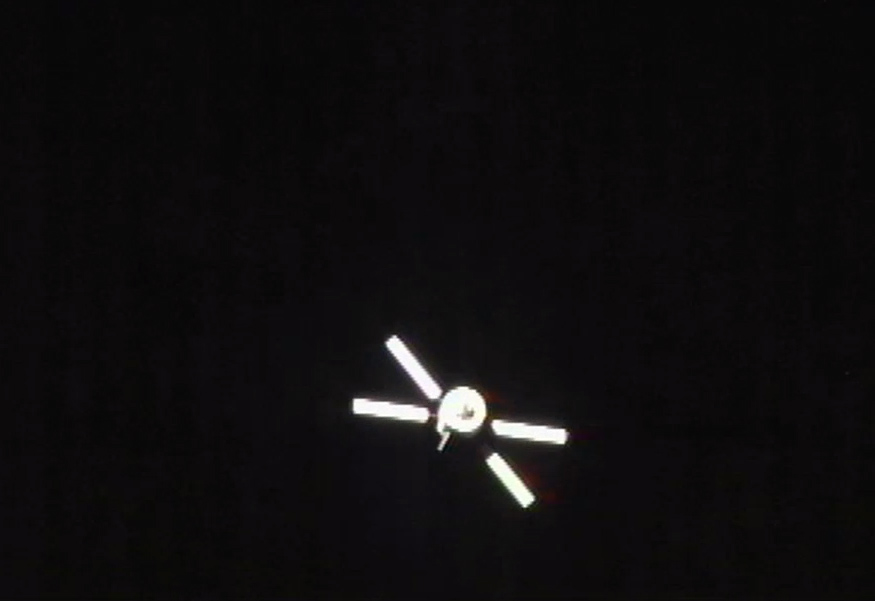Huge X-Wing-Like Cargo Ship Undocks from Space Station

An unmanned European cargo ship the size of a double-decker bus undocked from the International Space Station Friday (Sept. 28), ending a six-month delivery flight to the orbiting lab.
The robotic Automated Transfer Vehicle 3 (ATV-3), with its four X-wing-like solar arrays unfurled, cast off from the space station Friday as the two spacecraft sailed 255 miles (410 kilometers) over western Kazakhstan in Asia. The cargo ship's undocking occurred at 5:44 p.m. EDT (2144 GMT).
The space departure occurred three days later than planned due to delays, first by a computer glitch and later by space junk near the space station.
But Friday, the ATV-3 spacecraft, which is named the Edoardo Almadi after the famed late Italian physicist of the same name, made a flawless departure from the station. It will spend the next few days orbiting Earth before being intentionally destroyed on Tuesday (Oct. 3) by burning up in Earth's atmosphereover the Pacific Ocean. [Photos: Europe's Robotic ATV Spaceships]
"Today, everything has worked to perfection," NASA spokesman Rob Navias said during the agency's live broadcast of the undocking.
The ATV-3 spacecraft was built by the European Space Agency and delivered 7.2 tons of food, water and other vital supplies to astronauts aboard the International Space Station when it launched in March from a South American spaceport in Kourou, French Guiana. The ATV-3 spent 184 linked to the space station before being packed with trash and other unneeded items for its eventual fiery demise in Earth's atmosphere.
The ATV-3 is ESA's third unmanned cargo ship mission to visit the space station, which is also supplied by robotic cargo ships from Japan and Russia. In the United States, NASA has contracted two companies — SpaceX of Hawthorne, Calif., and Virginia-based Orbital Sciences Corp. — to provide unmanned cargo delivery flights to the station. The first official flight by SpaceX is scheduled to launch on Oct. 7, when the company
Get the Space.com Newsletter
Breaking space news, the latest updates on rocket launches, skywatching events and more!
The ATV craft are huge cylinders 32 feet long (10 meters) and nearly 15 feet wide (4.5 m) and may be visible by observers on Earth as a bright moving light in the night sky, weather permitting. The ATV-3, like the International Space Station, can be spotted if you know where to look.
To find out if the ATV-3 will be flying over your location, visit one of these websites and enter the information for your location:
The European Space Agency is also holding a photo contest for satellite trackers hoping to snap a photo of the ATV-3 as it orbits the Earth during the next few days. Prizes will be awarded for the best snapshots.
"We look forward to seeing any and all photos of ATV in free flight and we wish you happy snapping for the contest!" ESA officials said in blog post.
For more info on the ESA's photo contest for the ATV-3 spacecraft, visit: http://blogs.esa.int/atv/2012/09/28/atv-orbital-photo-contest-orbit-details/
The next ATV to launch toward the space station will be the ATV-4 Albert Einstein, which is slated to blast off in April 2013.
You can follow SPACE.com Managing Editor Tariq Malik on Twitter @tariqjmalik and SPACE.com on Twitter @Spacedotcom. We're also on Facebook & Google+.
Join our Space Forums to keep talking space on the latest missions, night sky and more! And if you have a news tip, correction or comment, let us know at: community@space.com.

Tariq is the Editor-in-Chief of Space.com and joined the team in 2001, first as an intern and staff writer, and later as an editor. He covers human spaceflight, exploration and space science, as well as skywatching and entertainment. He became Space.com's Managing Editor in 2009 and Editor-in-Chief in 2019. Before joining Space.com, Tariq was a staff reporter for The Los Angeles Times covering education and city beats in La Habra, Fullerton and Huntington Beach. In October 2022, Tariq received the Harry Kolcum Award for excellence in space reporting from the National Space Club Florida Committee. He is also an Eagle Scout (yes, he has the Space Exploration merit badge) and went to Space Camp four times as a kid and a fifth time as an adult. He has journalism degrees from the University of Southern California and New York University. You can find Tariq at Space.com and as the co-host to the This Week In Space podcast with space historian Rod Pyle on the TWiT network. To see his latest project, you can follow Tariq on Twitter @tariqjmalik.









